Art Guides
Here Are 7 Masterworks of Land Art Hidden Across the United States
Our guide to some of the key works of the movement (and where to find them).
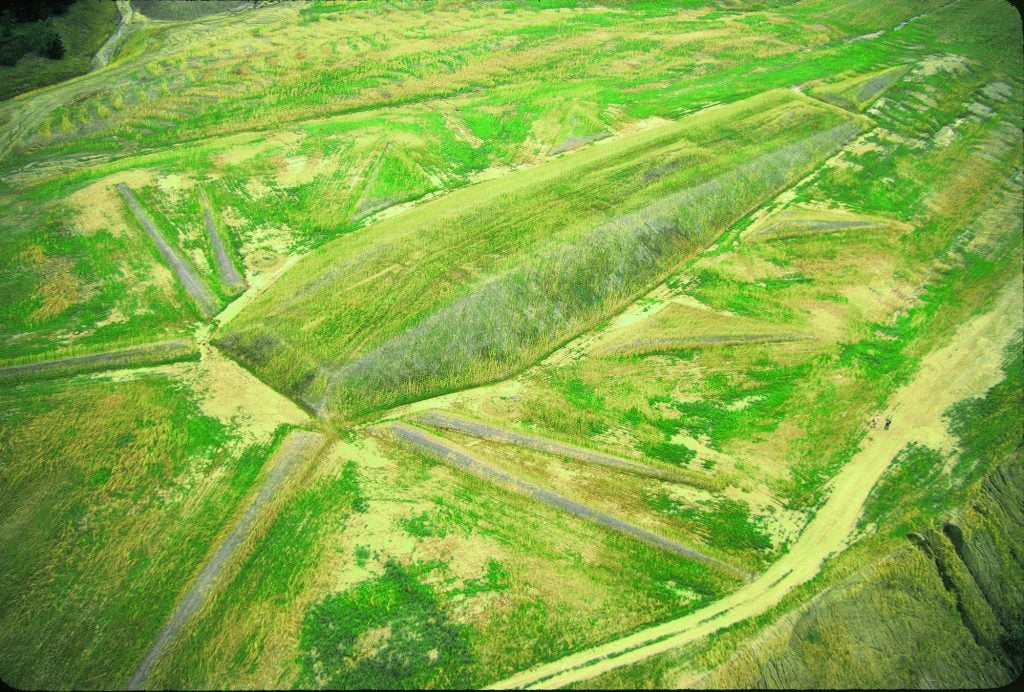
A sense of adventure powered the American land art movement of the 1960s and 70s. Artists went in search of remote and untamed places in which to dream up massive site-specific sculptures. Some of their creations have since become beloved visitor destinations, like Robert Smithson’s Spiral Jetty (1970) on the Great Salt Lake in Utah and Walter de Maria’s The Lightning Field (1977), which involves an overnight stay in the New Mexico wilderness.
Land art has never been easy to see. The journey—and the risk of getting lost along the way—are part of the experience. But even the movement’s die-hard fans will find some hidden gems still left to discover. Here, we compile a guide to the less celebrated, but no less captivating, land artworks across the United States that are worth hitting the road for—plus a couple so well hidden that you might never actually find them.
Robert Morris, Untitled (Johnson Pit #30) (1979)
SeaTac, Washington
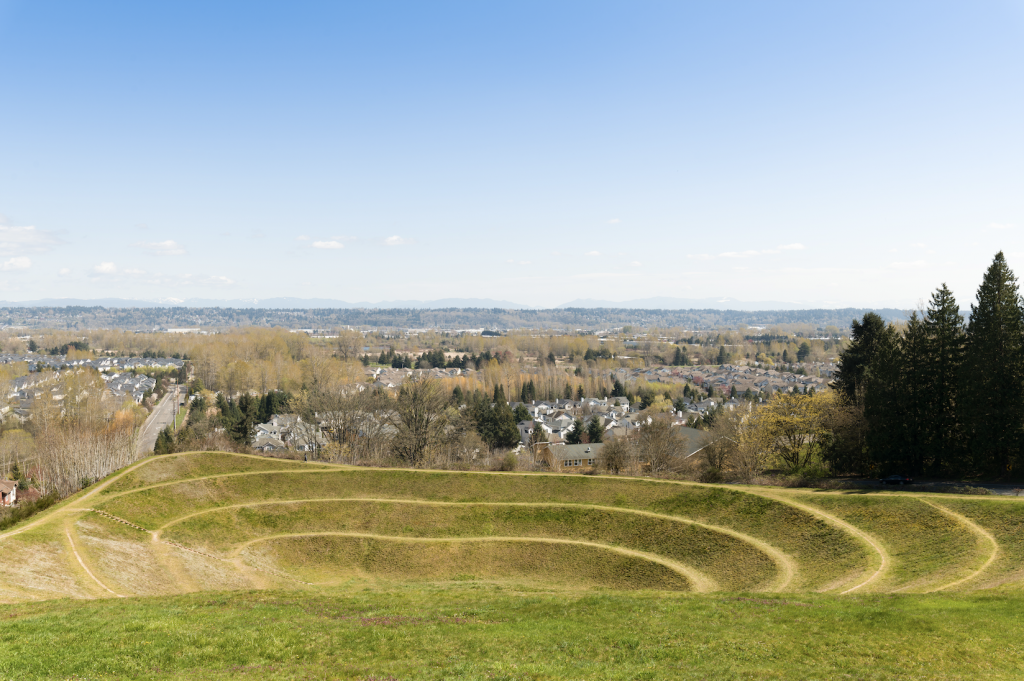
Robert Morris, Untitled Earthwork (Johnson Pit #30) (1979). King County Public Art Collection. Photo: joefreemanjunior.com.
In one of the first examples of a publicly-funded land art project, Robert Morris won a commission in 1979 to rehabilitate a disused mining pit outside Seattle. He moved 16,000 cubic yards of earth to transform the site into a grassy amphitheater of concentric slopes and terraces inspired by the Incan mountain complex Muyu-uray in Peru. Morris anticipated that the earth work would require minimal maintenance, but there were various structural complications over the years. In the 1990s, the artist approved changes to reinforce the terraces and add a public walking trail. As the earth work came under threat from development and vandalism, heritage experts successfully nominated it for protection on the Washington Heritage Register and National Register of Historic Places in 2021.
Here’s where you can find Untitled (Johnson Pit #30) in SeaTac, Washington.
Andrew Rogers, Rhythms of Life and Atlatl (2008)
Yucca Mesa, California
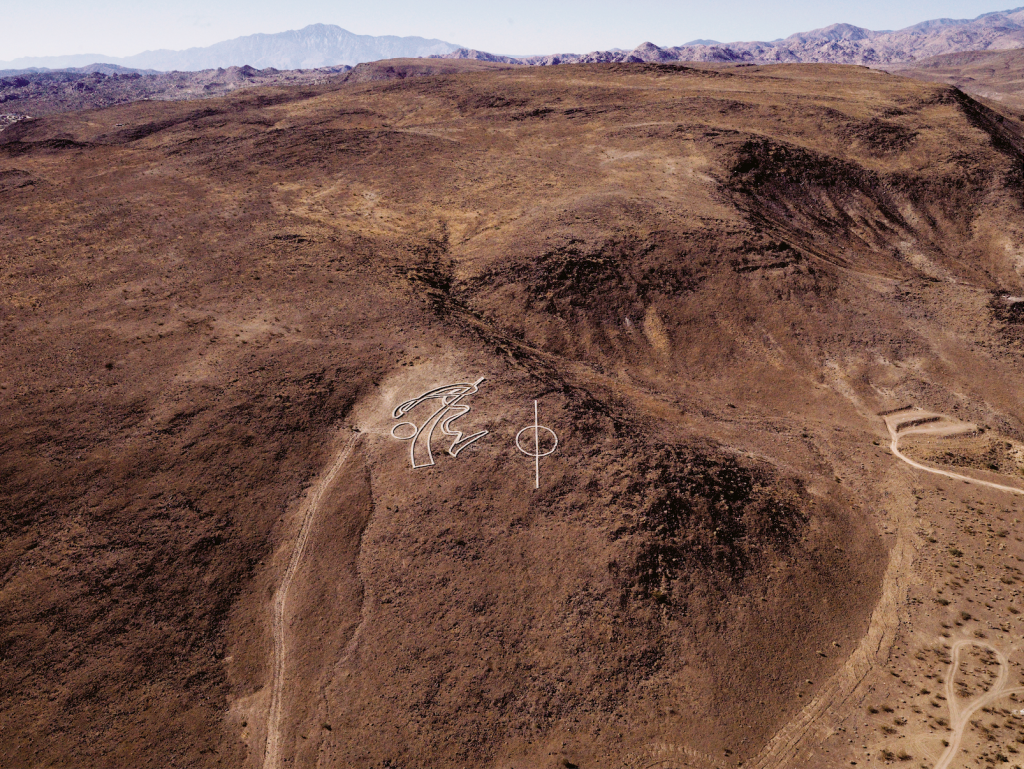
Andrew Rogers, Rhythms of Life (2008). Courtesy Andrew Rogers.
These two monumental geoglyphs near Joshua Tree National Park marked the culmination of a years-long land art project by Andrew Rogers called Rhythms of Life, spanning 51 sculptures across 16 countries. The California works reflect the history of the land, with one depicting an atlatl, an ancient spear-thrower linked to hunting and shamanism. The other shows an abstract twisting motif that recurs throughout Rogers’s series, symbolizing regeneration. The artist stacked 460 tons of stones to create the giant designs. “I recall climbing through the rocks and cliffs and thinking about who walked there in the past—their dreams and hopes,” he said in an interview. In time, his own creations will naturally disappear back into the desert landscape. “My work exists as a moment in time,” he added.
Here’s where you can find Rhythms of Life in Joshua Tree.
Karl Momen, Metaphor: The Tree of Utah (1986)
Bonneville Salt Flats near Wendover, Utah
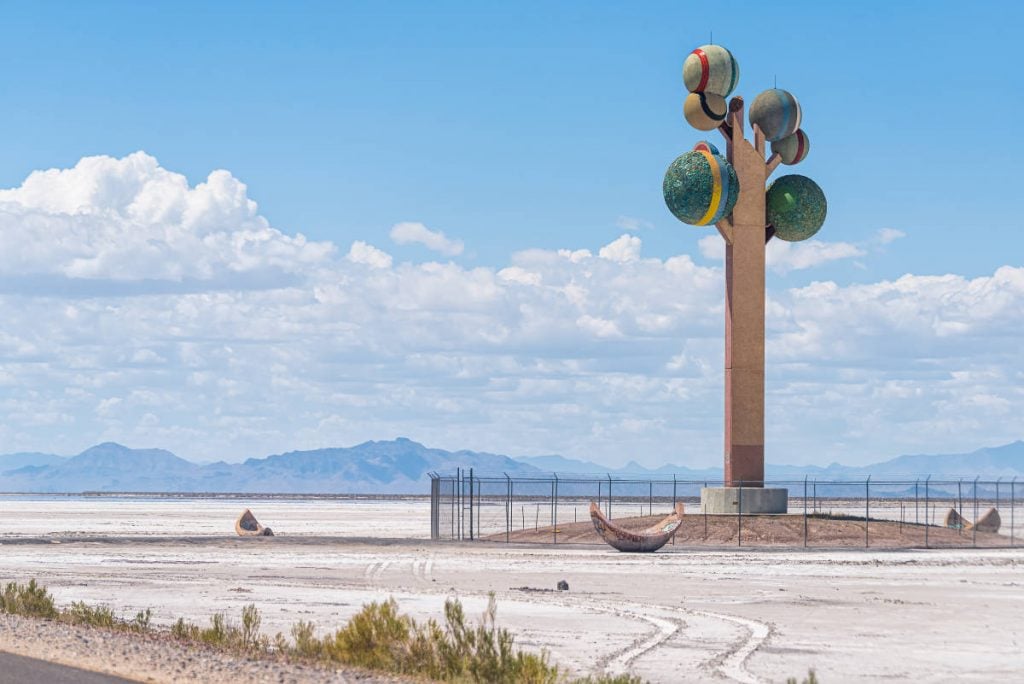
Karl Momen, Metaphor: The Tree of Utah (1986). Photo: Utah.com.
While driving west along the vast expanse of the Great Salt Lake Desert, Swedish artist Karl Momen had a flash of inspiration. His vision materialized as an 87-foot-tall “tree” with a concrete trunk and a canopy of spheres covered in a mosaic of local rocks and minerals. Momen self-financed the sculpture’s construction and donated it to the state of Utah in 1986. After his return to Europe, the work was mostly abandoned to the elements, and plans to build a visitor center and a new state road to the site appear to have stalled. The towering tree can be glimpsed from I-80, much as Momen imagined it in the 1980s, but curious visitors who pull over for a closer look could be ticketed. We reached out to the Utah Museum of Fine Arts for an update, and was told that the local landmark is “still surrounded by a chain-link fence, supposedly to protect viewers from falling pieces.”
Here’s where you can find Metaphor: The Tree of Utah in Bonneville Salt Flats.
Michelle Stuart, Stone Alignments/Solstice Cairns (1978-79)
Rowena Plateau near Mosier, Oregon
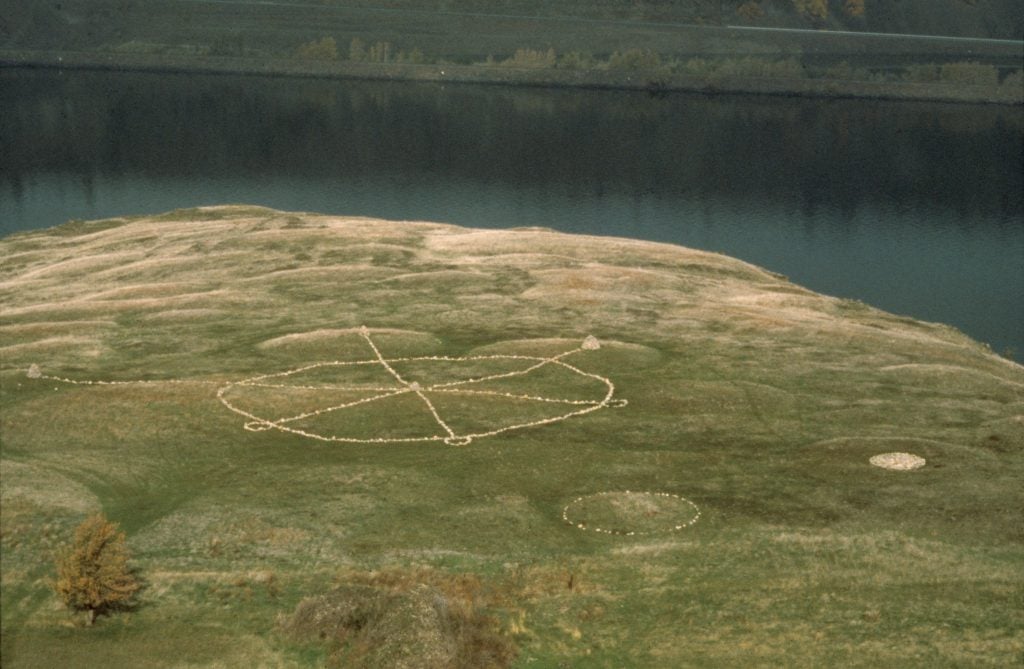
Michelle Stuart, Stone Alignments/Solstice Cairns (1979). Photo: © Michelle Stuart, courtesy the artist and Galerie Lelong & Co., New York.
Starting in the 1960s, Michelle Stuart created monumental works in the landscape with a consciously ephemeral approach. Her only surviving earth work formed a 100-foot-diameter stone circle out of a sequence of cairns. Stone Alignments/Solstice Cairns referenced ancient megalithic structures that align with the sun on the summer solstice, like Stonehenge and the Bighorn Medicine Wheel in Wyoming. Stuart proposed the work for an exhibition at the now-defunct Portland Center for the Visual Arts, which conserved it for about a decade. Later surrounded by private development (this work is, officially, no longer accessible to the public), the stones were overgrown and only accessible via a back road and winding trail in 2011, according to one intrepid local arts writer. Stuart “likes the idea that the work is like the standing stones in Britain,” said a spokesperson for Galerie Lelong & Co., allowing for time to “take its natural course.”
Richard Serra, Iron Mountain Run (2002)
South Kent, Connecticut
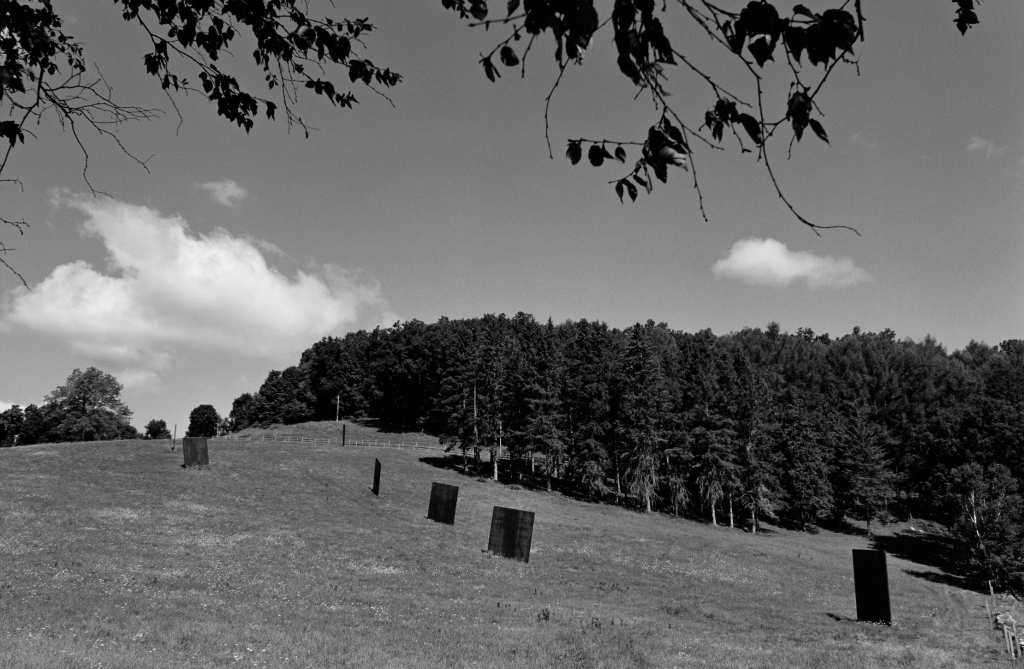
Richard Serra, Iron Mountain Run (2002). Collection Agnes Gund. Artwork: © Richard Serra/Artists Rights Society (ARS), New York. Photo: Loredana Nemes.
Seeing this work with your own eyes would require a personal invitation from collector Agnes Gund, who commissioned the late Richard Serra to create the installation for her farm in Connecticut. Seven weatherproof steel panels slope down a meadow and appear to sink into the landscape, each one measuring 15 square feet. From certain angles, the plates look “drunk,” Gund once said, like they are tumbling toward a nearby pond. She also recounted how cows on the farm would use the work as “a sort of shield from the wind and the sun,” in summertime. For those who can’t make it to the farm, there are several signature works by Serra in more accessible outdoor locations, like Schunnemunk Fork (1990-91) at the Storm King Art Center.
Here’s where you can find Iron Mountain Run in Connecticut.
Michael Heizer, Effigy Tumuli (1983–85)
Buffalo Rock State Park, Ottawa, Illinois
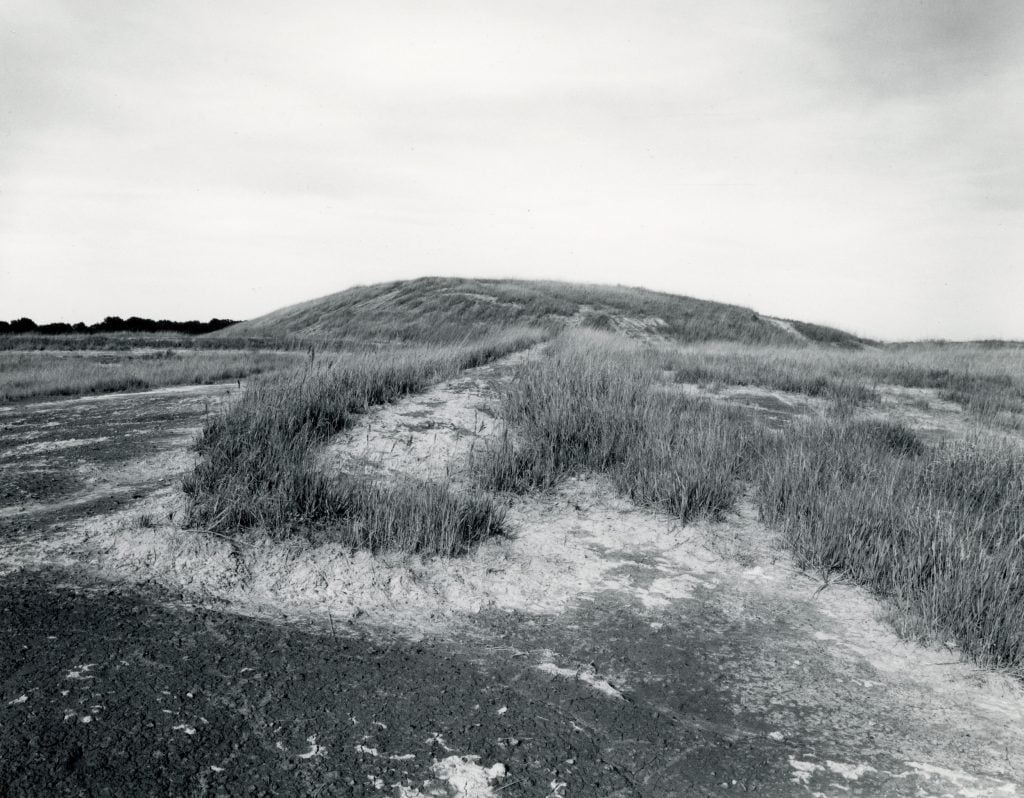
Michael Heizer, Effigy Tumuli (1983–85). Photographed in 1992 by Mark Ruwedel. Courtesy the artist.
Michael Heizer’s only representational earth work consists of five immense mounds in the shape of animals native to Illinois: a water strider, frog, catfish, turtle, and snake (the longest, measuring more than 2,000 feet from nose to tail). Effigy Tumuli evokes ancient Native American burial mounds—or tumuli—resembling animals, some which are found in the region. Spread across a bluff overlooking the Illinois river, the sculptures were commissioned as part of a reclamation project to turn ravaged coal mining land into a state park. Heizer’s work was nearly derailed by a public outcry over the cost, which ended up being $1 million. The artist had originally proposed eight animal mounds, but a salamander, bird, and beaver were dropped due to the limited funds.
Here’s where you can find Effigy Tumuli in Illinois.
Walter De Maria, Las Vegas Piece (1969)
Tula Desert near Overton, Nevada
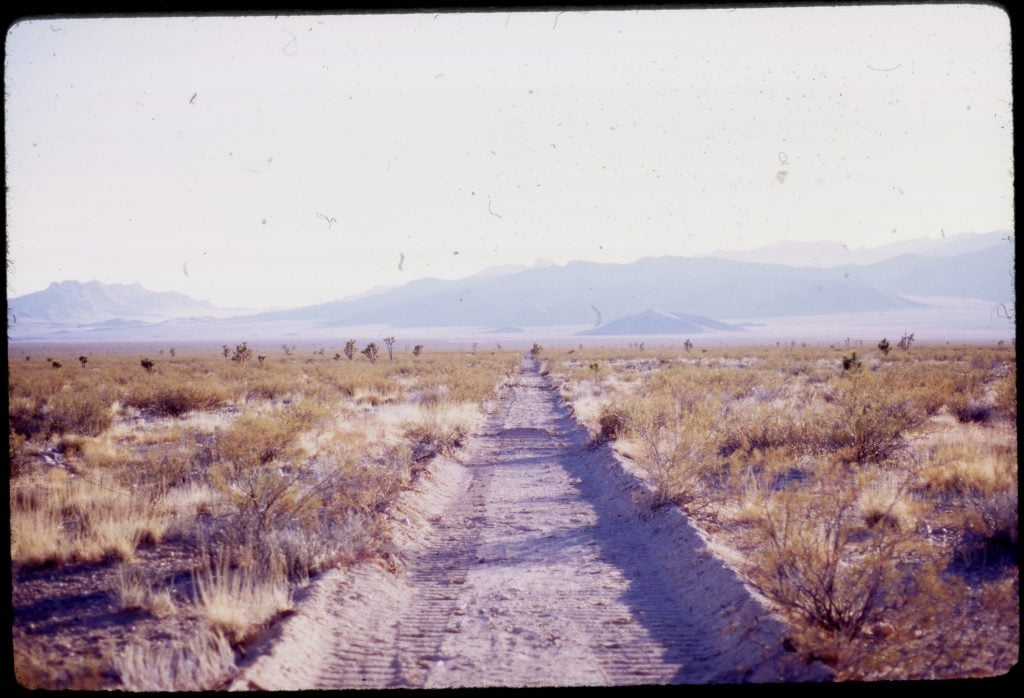
Walter de Maria, Las Vegas Piece (1969), ground level view, Desert Valley, Nevada. Photo: © The Estate of Walter De Maria, courtesy Walter De Maria Archive and Gagosian.
In a 1972 interview, Walter De Maria acknowledged the challenge of ever capturing Las Vegas Piece on camera. To make it, he cut three miles of lines into the desert floor that were around 10 feet wide and a foot deep in “a certain configuration.” Only a handful of photographs document its original state, and it presumably faded into the elements in the years after. The piece is so elusive that few people can even testify to having seen it. De Maria himself said it would take three hours to drive to the remote location from Las Vegas, then around 20 minutes of walking off-road. Experiencing the full extent of the piece required a four-hour journey on foot, navigating a dead end and a fork in the route (if you go, let us know if you have any luck). “The point I’m making here is that the most beautiful thing is to experience a work of art over a period of time,” he said.





